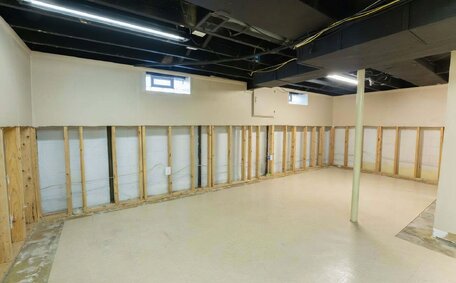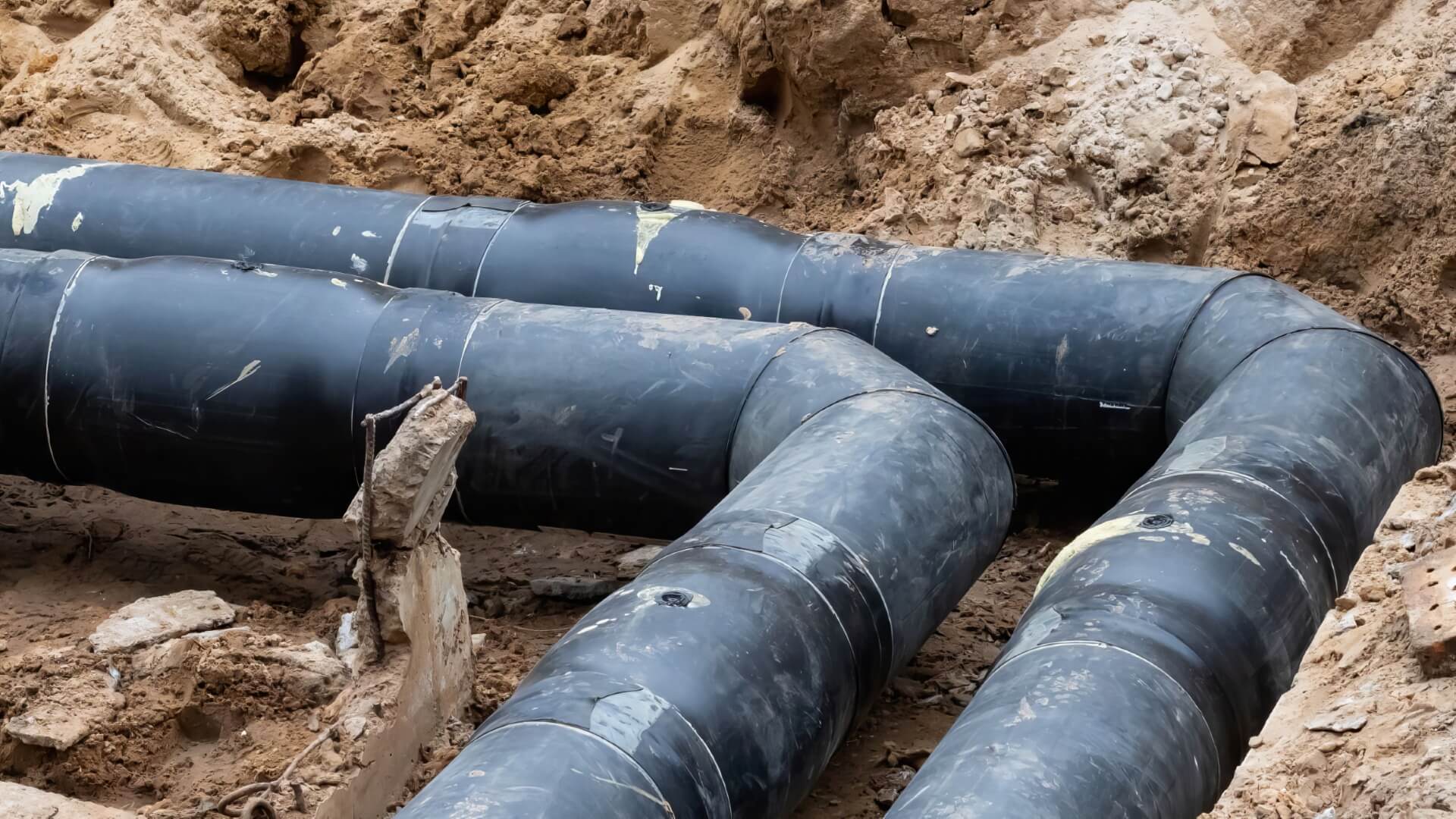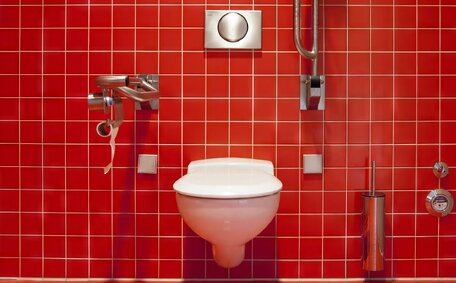What is Trenchless Pipe Relining?
Trenchless pipe relining is an advanced plumbing technique that repairs damaged pipes by inserting a resin-impregnated liner, creating a new pipe within the old one without the need for excavation.
In contrast to traditional pipe replacement, trenchless relining is minimally invasive, restoring pipes to full functionality with negligible disruption. This method is quicker, more economical, and minimally impacts surrounding structures and the environment.
Trenchless pipe relining offers several key advantages:
- Minimal digging and disruption to floors, walls, landscaping etc
- Significantly less expensive than full pipe replacement
- Much faster with most jobs completed in 1-2 days
- Long lasting repairs that can extend the pipe’s lifetime by 50+ years
- Improved flow rates and pressure
- No destruction of surrounding structures/landscaping
- Environmentally friendly with reduced carbon footprint
Damaged sewer lines and plumbing pipes can be restored using trenchless relining, avoiding the disruption and cost associated with traditional trenching methods. It’s suitable for pipe repairs both inside and outside the home.
Trenchless Pipe Relining Methods and Materials
There are two main trenchless pipe relining methods used - Cured-in-Place Pipe (CIPP) lining and pipe bursting.
Cured-In-Place Pipe (CIPP) Lining
Cured-in-place pipe (CIPP) lining, commonly employed in trenchless techniques, fortifies the inside of old infrastructure. It involves inserting a resin-saturated felt tube into the damaged pipe and curing it in place using hot water, steam, or UV light to form a smooth, jointless, watertight new pipe within the old one.
The resin-saturated liner bonds firmly to the original pipe wall, with the curing process taking between 30 minutes to a few hours depending on the method and pipe size. Once cured, the liner extends the pipe’s lifespan for decades while restoring flow capacity, pressure ratings, and chemical resistance.
Epoxy resin liners offer the strongest CIPP solution with outstanding chemical resistance. Standard polyester or vinyl ester resin CIPP liners provide excellent value for straightforward sewer and stormwater repairs.
Pipe Bursting
Pipe bursting uses powerful hydraulic equipment to break up old damaged pipes while simultaneously replacing them with new pipes of the same or larger diameter. It’s suitable when upsizing the pipe size for improved capacity is needed.
High density polyethylene (HDPE) is the standard material used for pipe bursting due to its strength, durability, flexibility, and water tightness. Other thermoplastic pipe materials like PVC may also be used depending on site requirements.
Pipe bursting causes more ground disturbance than CIPP lining so is usually only used where major upsizing is needed or the original pipe is so damaged that lining is not feasible.
Benefits of Trenchless Pipe Relining
Residential relining jobs spanning 60-100 metres could cost AUD 260-400 per metre, versus AUD 550-750 per metre for traditional replacement.
Trenchless relining facilitates drain pipe restoration with minimal disturbance as no trench digging is required.
CIPP lining requires only two small access points at each end of the pipe, greatly simplifying the repair process. The convenience of trenchless technology is often appreciated by homeowners who can stay in their homes while repairs are completed.
Speed & Convenience
Trenchless repairs are completed much faster than traditional methods. Trenchless repairs are often completed in 1-2 days, as opposed to a week-long process for traditional replacements.
The lack of excavation also means specialist landscaping and surface restoration teams aren’t required which further reduces time and hassle for homeowners.
Longevity & Durability
High tech trenchless lining materials like epoxy and polyurethane resin boast exceptional durability and corrosion resistance. They prevent infiltration and root intrusion while providing leak-free operation.
Trenchless relining can add more than 50 years to a pipe’s functional lifespan. Many trenchless solutions include long-term guarantees, offering homeowners assurance against future issues.
Typical CIPP installations produce around 70% less carbon emissions than traditional replacement methods.
Homeowners and the community benefit from the reduced waste, transport, noise, and fossil fuel usage.
Cost Savings
Trenchless relining is significantly more cost-effective than traditional open-trench pipe replacement. Excavation, removal of old pipes, surface restoration and landscaping can account for 50-60% of traditional pipe replacement costs.
With trenchless methods this extensive physical work is avoided, reducing overall project costs by 30-50%. For a typical residential job, trenchless pipe relining costs around $100 per linear foot installed compared to $180-$250 per foot for full replacement.
The resin materials used in trenchless lining are also cheaper than traditional piping. When you factor in the reduced labour and absence of heavy equipment too, the cost savings quickly add up across large and small-scale relining projects.
Minimal Disruption
One of the biggest benefits of trenchless pipe relining is the minimal disruption it causes compared to traditional open-trench methods.
Because no trenches or excavations are required, a trenchless relining can be carried out with very little disturbance to the surrounding property. Technicians simply need access to the pipe endpoints in order to feed the CIPP lining material through the damaged pipe.
Access is usually via two small 30-50mm holes that are neatly core drilled, avoiding any damage.
The process also eliminates the need for restoration work post-repair. Upon completion, the process leaves virtually no evidence of the work done.
Gardens, paths, and driveways remain undisturbed, with no risk to fences or garden beds.
Walls and floors may need demolishing while front or backyards get completely dug up.
In contrast, trenchless relining rehabilitates pipes in place, significantly reducing disruption.
Speed and Convenience
Trenchless relining is a much faster pipe repair solution than traditional replacement methods. Jobs can typically be completed within 1-2 days, thanks to the absence of any excavation or restoration works.
CIPP lining in particular can be installed rapidly, with the resin-saturated tube inflated and cured within the pipe in just a few hours. This swift 1-2 day turnaround contrasts with the 3-5 days typically needed for open-trench pipe replacement.
Homeowners can continue their daily life undisturbed during internal pipe repairs thanks to the non-intrusive method. Furthermore, external areas including gardens, landscaping, and driveways remain unscathed.
Longevity and Durability
CIPP linings consist of a resin-saturated fabric that hardens inside the old pipe to form a strong new conduit. Epoxy resins in particular create an exceptionally strong CIPP liner with outstanding corrosion resistance.
Environmental Impact
Trenchless pipe relining is a much more environmentally friendly repair method compared to traditional pipe replacement techniques.
Additionally, avoiding excavation helps to preserve surrounding vegetation and tree roots.
It’s acknowledged as a sustainable, low-impact method for pipe remediation, increasingly favoured by industry professionals.
Trenchless Pipe Relining Process
Initial CCTV Pipe Inspection
The first step is a thorough CCTV pipe inspection. A detailed CCTV inspection is conducted to identify pipe damage and confirm the suitability of trenchless relining. The footage lets technicians analyse the pipe condition, pinpoint problems, and develop a tailored relining plan.
Pipe Preparation
Cleaning and preparation of the pipe proceed with high-pressure water jetting. This clears any obstructions to ensure the new liner can be smoothly inserted the entire length. Service connections and joints may be adjusted as necessary to facilitate smooth liner installation.
Resin-Saturated Liner Installation
The main trenchless repair phase involves saturating the liner tube with liquid epoxy or polyurethane resin before insertion. The liner is inflated and pulled into position, conforming tightly to the pipe walls. Hot water, steam, or UV light then cures the resin-infused liner to form a smooth, jointless new pipe within the old one.
Service Reconnection
Once cured, the new pipe’s connections and junctions are precisely reinstated using advanced robotic cutters. The pipe ends up better than new once this precision reconnection work is complete.
Final CCTV Inspection
A concluding CCTV inspection confirms the seamless completion of the relining process. The resulting video lets homeowners visualise the pristine pipe interior and provides plumbers with a quality record. Regular inspections going forward are recommended to catch any future issues early.
When is Trenchless Pipe Relining Appropriate?
Trenchless pipe relining is suitable for repairing damaged but largely intact pipes suffering from issues like cracks, leaks, root intrusion or corrosion damage. It’s commonly used to rehabilitate sewer lines, enhancing the integrity and function of the critical waste removal infrastructure.
Trenchless relining allows pipes with limited structural damage to be restored from the inside out, perfect for targeted sewer repair. As long as the existing pipe maintains its basic shape and integrity, a liner can be inserted and expanded to form a protective new pipe within.
However, fully collapsed, severely misaligned or fragmented pipes are not good trenchless relining candidates. The liner material needs a moderately solid host pipe to brace against during installation and curing. Sections with major holes, breaks or blockages also pose issues.
A full pipe replacement may be better for completely degraded pipes or where very old asbestos or clay piping needs removing. An initial CCTV pipe inspection helps determine if trenchless relining is feasible or if full excavation and replacement is the better fix.
Contact St Peters Plumbing Today
St Peters Plumbing has been delivering outstanding plumbing services to Sydney homeowners for over a decade. Our licensed experts proficiently diagnose pipe issues to ascertain if trenchless relining is the optimal solution.
We employ cutting-edge trenchless repair techniques and high-quality CIPP materials, offering durable solutions that prolong your pipe’s life with minimal disruption.
To learn more about relining your damaged sewer, drain or water pipes the fast non-invasive way, contact St Peters Plumbing today:
- Phone: 1300 349 338
- Email: jobs@stpetersplumbingservices.com.au
- Or request an appointment online at your convenience
Leverage St Peters Plumbing’s expertise in trenchless solutions for quick, cost-effective, and fuss-free resolution to your pipe issues. Get in touch to discuss your relining possibilities!






